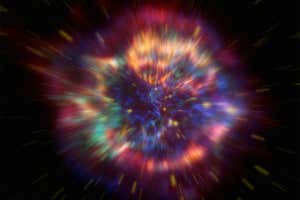[ad_1]

Worldspec/NASA/ Alamy
You may have heard that we are all stardust, but that isn’t strictly true. There are about 20 different elements in the human body, most of which were made inside ancient stars. There’s oxygen, which makes up about half of your body’s mass but only a quarter of its atoms, and then carbon, accounting for another 12 per cent. And just after that, there’s hydrogen, the only element in your body that wasn’t made inside a star long ago and flung into space by a supernova explosion. The hydrogen atoms in your body, accounting for a little over 10 per cent of you, were formed much earlier during the Big Bang, some 13.8 billion years ago.
The smallest insect on Earth is a wasp

The Mymaridae, commonly known as fairyflies or fairy wasps.
Scenics & Science / Alamy
Advertisement
There are more than 110,000 known species of wasp, and while we tend to think of them as the black-and-yellow-striped nuisances, wasps come in a huge variety of shapes and sizes. Only one third of species have stings, for instance, and while some live in colonies, the vast majority of wasp species are solitary. There’s even a wasp that can lay claim to the title of smallest insect on the planet. The Mymaridae or fairy wasp has a body length of just 0.139mm, shorter than that of an amoeba.
The first space walker became trapped outside his ship

Over the Black Sea. Museum: Memorial Museum of Cosmonautics, Moscow. Author: Leonov, Alexei Arkhipovich.
Album / Alamy
Alexei Leonov became the first person to walk in space when, on 18 March 1965, he left the Voskhod 3KD spacecraft for 12 minutes. Although he spent such a short time alone in the vacuum of space, the walk was not without incident. Free from the atmospheric pressures of the spacecraft, his space suit ballooned, preventing him from getting back inside the airlock. Leonov had to bleed his suit of air until it was flexible enough for him to get back inside the ship. Despite the rapid decompression resulting in Leonov developing the bends, he made it back inside safely and returned to Earth shortly afterwards.
Marie Curie’s notebooks are still radioactive

Holograph note-book containing notes of experiments, etc. on radioactive substances, with rough pen-drawings of apparatus.
Public Domain Mark/Wellcome Collection
Marie Curie was a physicist and chemist who became the first woman to win a Nobel prize. Along with her husband Pierre, she discovered two elements: polonium and radium. She also carried out pioneering research into radioactivity. At the time no one knew about the effects of radioactivity on the body, so they handled the elements they used in their research without any of the precautions or protective clothing we would use today. Curie even kept vials of what she was working on in her pockets or her desk drawers. More than 100 years after their discoveries, the couple’s notebooks are still so radioactive they have to be kept in lead-lined boxes and handled only while wearing protective clothing.
The largest dinosaur could have weighed 120 tonnes

Public life size model of Patagotitan dinosaur
Josh Forwood/Alamy
Fossil remains of truly huge dinosaurs have been limited but after an astounding discovery in 2013, six specimens of a truly enormous beast, Patagotitan, started to emerge from the ground.
Since Patagotitan was discovered, it has often been described as the largest animal ever to walk the earth. Estimating the weight of these dinosaurs is not straightforward but recent analyses are in broad agreement. Patagotitan comes in at a whopping 55 tonnes, which is ten times the mass of an elephant, the largest living land animal.
However, a reappraisal of a dinosaur found in 1878 suggests it might have been twice as heavy as Patagotitan. The estimate is contentious, but if correct it would make Amphicoelias fragillimus, between 80 and 120 tonnes
On average, every square metre of land is home to 130 spiders

Jumping spider (Hypaeusbenignus) seen in rainforest of Costa Rica.
Avalon.red/Alamy
Recent studies of web building and other spider behaviours have revealed that these arachnids possess unexpected intelligence. Their cognitive abilities include foresight and planning, complex learning, memory and the capacity to be surprised. Today, more than 48,000 spider species have been identified. They are hugely adaptable, living everywhere from the most northerly islands of the Arctic to deserts, caves, seashores and bogs. The Himalayan jumping spider even flourishes at altitudes above 6 kilometres, making it one of the world’s highest residents. On average, every square metre of land on Earth is home to 130 spiders.
More on these topics:
[ad_2]
Source link




